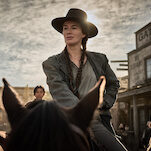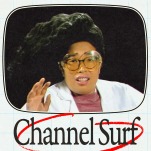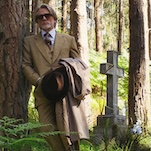What makes the NFL draft so fascinating is the infinite number of ways it can play out. There are 32 different teams with 32 different philosophies when it comes to evaluating the best collegiate prospects. Each team has holes at specific positions, and no teams have quite the same combinations of needs. Because there are so many different positions, each featuring distinct skill sets, it’s not always easy to determine whether, say, a running back prospect is “better” than a defensive lineman, though it’s generally understood that a potential franchise quarterback trumps all other contenders. With each player that comes off the board, teams must reassess and sometimes completely alter their draft strategy.
There’s an entire cottage industry devoted to projecting just how the draft will shake out, but even Mel Kiper Jr., the most famous of the current generation of mock draft experts, would readily admit that these predictions are only best guesses, and they can’t account for teams’ propensity for unconventional, sometimes questionable decision-making, let alone their ability to trade draft picks. Teams draft players not only because they need them but also because they want to ensure no other team can have them or, if another team desires this newly acquired player, that they must pay a steep price for the privilege. It’s as though each team is playing 31 different games of poker (or chess, or perhaps even Risk) with the 31 other teams.
ESPN’s latest 30 For 30 effort, Elway To Marino, attempts to chronicle all the intrigues and convolutions of the first round of the 1983 NFL Draft, in which six quarterbacks, 15 Pro Bowlers, and seven Hall of Famers (not to mention Richard Dent, who was taken in the eighth round) were selected. As the title suggests, that year’s draft was dominated by two star quarterback prospects, John Elway and Dan Marino, both of whom went on to have top 10 careers in the NFL, and even that might be underselling their impact; the documentary’s main subject, agent Marvin Demoff, calls them the two greatest quarterbacks in NFL history, and it’s a defensible (if controversial) position. That knowledge of their future success—not to mention the ignominious failures of other first round selections—adds rich dramatic irony to the proceedings, particularly as Marino hears five other quarterbacks’ names called before the Miami Dolphins finally select him with the penultimate pick of the first round.
Elway To Marino is at its best when it explores the myriad of alternate histories that could have played out if even one team had made a different choice. Elway’s refusal to play for the dysfunctional, directionless Baltimore Colts, who possessed the first pick, leads to protracted discussions between Demoff and the Colts front office about potential trade scenarios, while Elway himself publicly postures about being a California guy who doesn’t want to play on the East Coast, a flimsy pretense Demoff wryly admits was “not as well thought out as it could have been.” Anyone with even passing familiarity with the NFL likely knows that Elway will end up with the Denver Broncos, but that team doesn’t enter the picture until very late in the story; before they emerge, several teams desperately try to assemble the picks necessary to pry Elway from the Colts. In the craziest scenario, the San Francisco 49ers actually suggest trading Elway for Joe Montana, who had won his first of four Super Bowls the year before. This is presented as little more than an idle thought on the part of 49ers coach Bill Walsh, and the present-day Elway admits that might have been a slightly difficult situation to step into.
Each new trade scenario offers a different insight into the insanity of the draft process. The San Diego Chargers, an obvious fit for the California-bred Elway, likely only pursue the quarterback to gain leverage in tempestuous owner Eugene Klein’s contract dispute with franchise star Dan Fouts. It wouldn’t be a documentary featuring the then-Los Angeles Raiders without a good, old-fashioned Al Davis conspiracy theory, as the late owner’s lieutenants suggest NFL commissioner Pete Rozelle personally intervened to stop a draft pick swap between the Raiders and Chicago Bears that would have in turn allowed Davis’ team to acquire Elway. It’s all as convoluted and irrational as it sounds, and it’s oddly fascinating to dive down these various rabbit holes to consider what might have been.
One of the strongest points Elway To Marino makes is that teams, despite being billion-dollar enterprises, don’t necessarily make carefully considered, rational decisions about what’s in their best interests going forward, and that team owners can make franchise-altering decisions on the slightest of whims. A Dallas Cowboys representative explains he put together a fair trade for Elway designed to appeal to Colts coach Frank Kush—it included Cowboys quarterback Danny White, who had played for Kush at Arizona State—without realizing that Kush could be overruled at any moment by Colts owner Robert Irsay. Indeed, as Colts general manager Ernie Accorsi argues, the only reason Elway was eventually traded to the Broncos was because Irsay happened to be good friends with Denver owner Edgar Kaiser, and so Irsay agreed to a lopsided trade for no other reason than because he wanted to be done with the whole mess.
Elway To Marino is an NFL Films production and, like previous league-produced 30 For 30 efforts such as Four Days In October and Once Brothers, it suffers from a superficial, uncritical approach to its subject matter. There are legitimate, fundamental criticisms one can make of the NFL draft process, many of which are briefly raised in the documentary but then never explored. In justifying Elway’s trade demands, Demoff argues that he wasn’t forced to join a legal firm in Des Moines when he graduated law school; he had the right to choose where he wanted to work, and he suggests Elway shouldn’t lose that freedom just because his chosen profession is football.
At least that objection is acknowledged, if only to kick off the more technical story of the various trade possibilities. In its discussion of Marino and his falling draft stock, the film elides the ethics of a league-wide whisper campaign that claimed Marino’s production at the University of Pittsburgh had plummeted because of drug use. Marino’s roommate and fellow first round pick Jim Covert mentions being questioned about his own drug use, with Marino’s taken as a given, during the draft process. The Raiders even admit they passed on Marino purely because of these unfounded rumors, something all involved say they now painfully regret. This uglier side of the draft deserves more in-depth discussion than is possible in an in-house documentary; even if they are ultimately judged to be necessary evils, it seems incomplete to delve this far into Elway and Marino’s stories without really discussing the underlying philosophical issues. The archive footage can’t help but make the argument, but it’s toothless.
The other problem with Elway To Marino is one of tone; Tom Selleck brings a grizzled gravitas to the narration, while the music and camera choices lend the film a solemn, dramatic feel that doesn’t quite fit the material. This is a weird, winding technical story, a comedy of errors in which the participants find new ways to sabotage themselves at seemingly every turn. The interviewees all seem to recognize the fundamental ridiculousness of the 1983 draft’s intrigues and posturing, but NFL Films sometimes treats the subject matter with the same solemn dignity it might afford a Super Bowl highlight reel. The only time Elway To Marino really carries off that tone is when it invokes the weight of history, as each of the 28 draft choices’ careers are reduced to single captions and blurbs. One particularly effective sequence silently presents the fates of four consecutive picks: all-time bust Michael Haddix, Hall of Famer Bruce Matthews, serviceable pro Terry Kinard, and Tim Lewis, whose career was cut short after a devastating neck injury. That sequence lays bare the other great fascination of the NFL draft; for that one day, all the selections are at the peak of their potential, and every single one has the chance to be a star. As time goes on, the draft remains a snapshot of that brief, hopeful moment, before history determined which would succeed, fail, or never really have the chance to live out their dreams. The NFL draft presents infinite possibilities, but what might have been is only rarely as compelling as what actually happened.
Stray observations:
- As you can probably guess from the title, Elway To Marino focuses primarily on only two of the six quarterbacks. There’s probably a different documentary that traces the divergent careers of the six players, but it’s hard to argue too much with the relative amounts of attention given to Elway, Marino, Todd Blackledge, Tony Eason, and Ken O’Brien—indeed, I finished the movie with newfound appreciation for O’Brien’s underrated career. The big exception is Jim Kelly, who is a Hall of Famer in his own right and famously spurned the Buffalo Bills to go play in the upstart USFL; while that’s all addressed here and Kelly himself is a fun interview subject, that whole story feels like an afterthought.
- Another great presence in the film is Chris Hinton, the offensive lineman who was originally drafted by the Denver Broncos and then traded to the Colts for John Elway. He appears impressively unperturbed by the fact that he will always be known as the guy traded for Elway. But, as he points out, even if Elway had stayed with the Colts, who would have blocked for him?
- Between John Elway almost leaving football for the New York Yankees and the previous 30 For 30 entry You Don’t Know Bo, I’d be up for an entire documentary on two-sport athletes and the unlikely lineups that might have been. A Yankees World Series champion led by Elway and Don Mattingly is one hell of a crazy thought, and I’m using it in all my unpublished alternate history short fiction.
- Intentionally or not, Ernie Accorsi sums up the insanity of the draft process when he reveals Marino would have been perfect for the Colts, but they took Elway, despite the fact that he definitely didn’t want to play for them, “because Elway was the pick.”
- No matter the year, it’s always amazing to watch Jets fans boo their team’s first round draft pick.
- I look forward to watching this film’s sequel, Luck To Griffin (And Then Later To Wilson), in 2043.









































